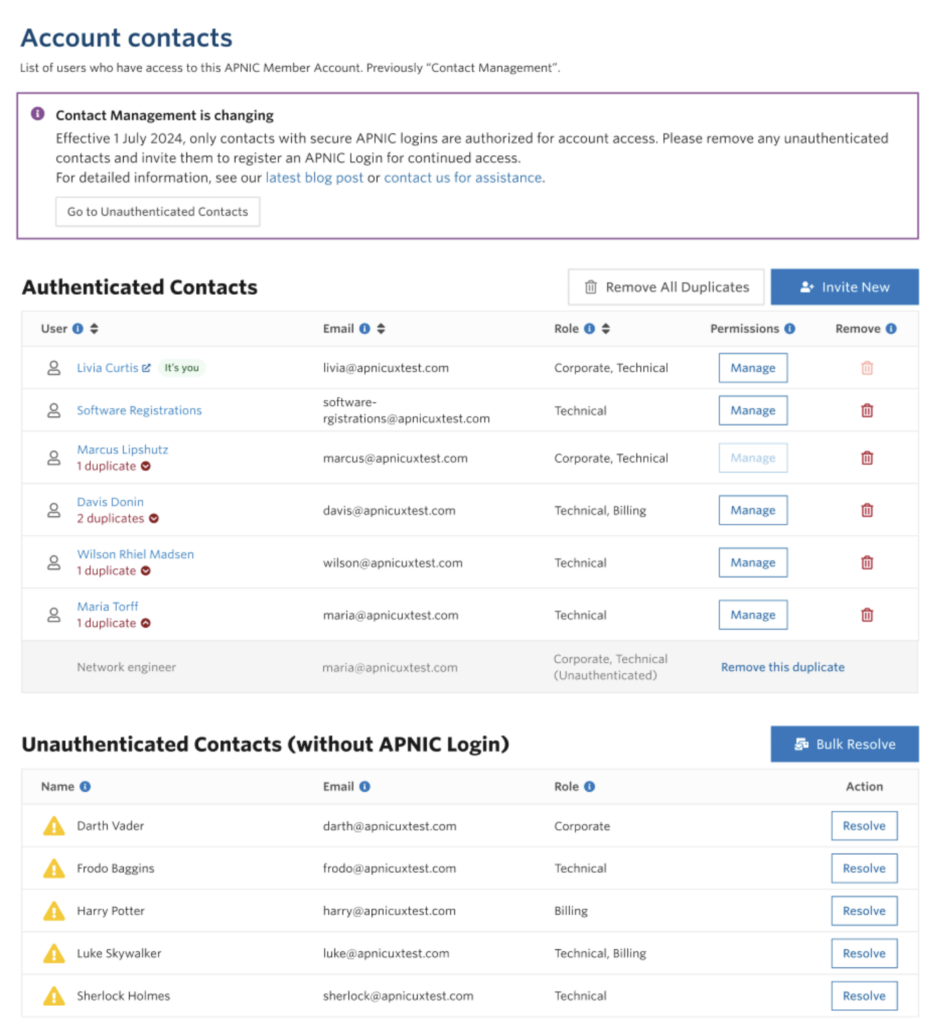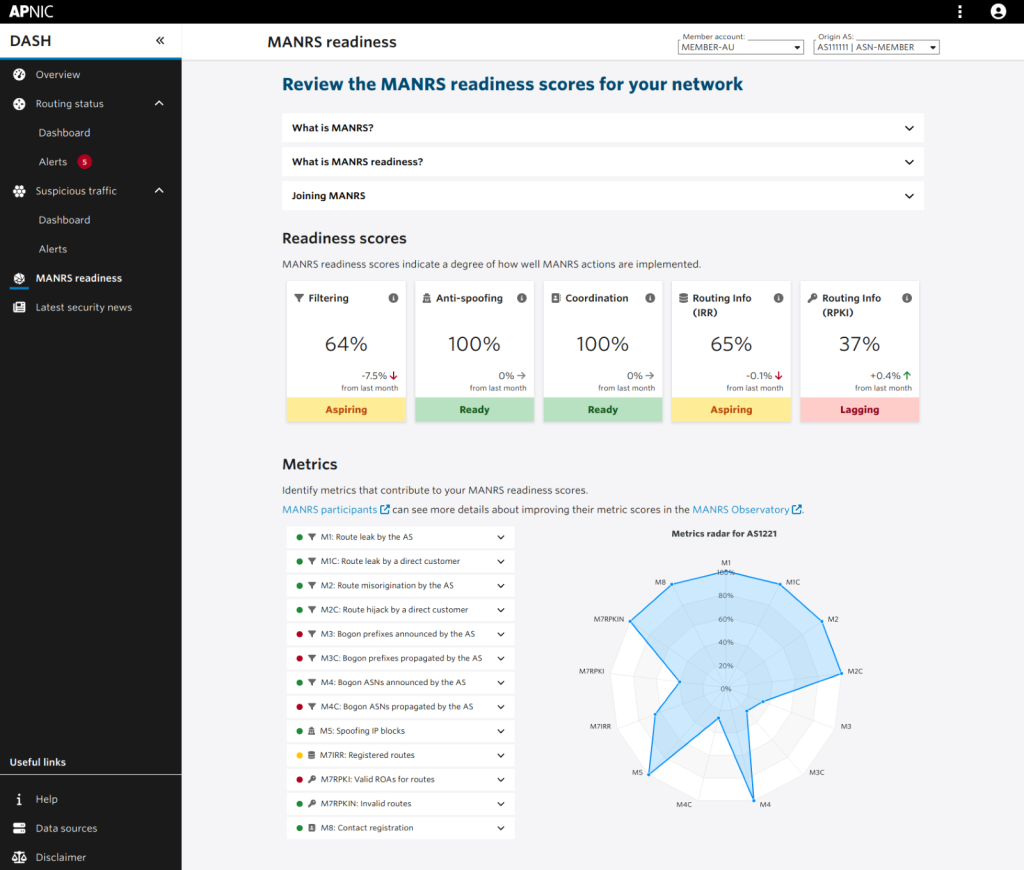
2024 was a highly productive year for APNIC’s four product development teams — Membership, Registry, Academy, and Information. This post highlights key projects and initiatives undertaken over the past year.
Membership products
Membership contact management enhancements
Significant improvements were made to streamline the Contact Management pages in MyAPNIC, enhancing user and permission management. The redesigned interface streamlines account management by clearly identifying users with and without logins and provides simple tools to deprecate contacts without an APNIC Login.

Renewal quote generation
A self-service renewal quote generation feature was introduced in MyAPNIC, allowing Members to generate quotes based on their current resource holdings for one, two, or three years in advance. This replaces the manual process and enables better budget planning.
Reporting harmful content on Orbit
Posts on Orbit that violate APNIC guidelines or contain harmful content can now be reported. This streamlines the reporting process and provides moderators with improved tools for managing reported posts. Learn more about these Orbit updates.

Access to important documentation in MyAPNIC
A new section in MyAPNIC now allows Members to download key account documents, including Signed Membership Agreements and Resource Allocation Letters, which are automatically generated within the portal.
Authenticated chat for secure Member support
Online chat in My APNIC is now authenticated, enabling secure, private communication between Members and APNIC staff.
Prop-155 implementation support
Significant updates were made to support the implementation of prop-155: IPv6 PI assignment for associate members. These included changes to voting rights for affected organizations and updates to the public and Member fee calculators to ensure accurate fee calculations.
Enhancements to the APNIC invalid contact reporting form
Invalid contact reporting has been improved for better usability. The form now only accepts submissions for IP addresses delegated to RIRs, excluding those reserved by IANA for other purposes. Additionally, it now supports reporting for Autonomous System Numbers (ASNs).
APNIC Foundation website relaunch
The APNIC Foundation launched a new website in 2024, integrating content from the former ISIF Asia site. The redesigned platform includes a blog and an updated layout for improved usability.
Improved APNIC website search functionality
It is significantly easier for users to find relevant content on all APNIC-related sites. Search functionality now transitions across APNIC domains, improving access to content from the APNIC website, knowledge base, APNIC Academy, APNIC Blog, and other related sites.
Upgrade to OKTA identity engine
APNIC upgraded its identity management system to OKTA’s latest engine, enhancing security while simplifying the authentication experience for users.
Improvements to test and UAT environments
The first phase of a four-year initiative to improve APNIC’s Test and User Acceptance Testing (UAT) environments was completed, focusing on efficiency, reliability, and accuracy. These changes help streamline the development cycle, reduce operational costs, and mitigate risks associated with testing.
Migration of legacy ticketing system to Salesforce CRM
Phase 1 of migrating APNIC’s RT help desk system to Salesforce CRM was completed. This transition aims to leverage advanced analytics, automation, and integrated communication tools to improve ticket tracking and resolution efficiency, and enhance Member support.
Registry products
Registry API
APNIC deployed a registry API enabling scripted updates to whois objects, RPKI ROAs, and reverse DNS records. This integration streamlines workflows and reduces manual input errors.
Whois improvements
APNIC migrated the whois Near Real-Time Mirroring (NRTM) service to IRRd v4, replacing deprecated RIPE database software. This upgrade introduces new features, including potential support for NRTM v4. APNIC also contributed various upstream improvements as part of this project.
RPKI updates
- RPKI signed checklists: Implementation was completed but remains under legal review before deployment.
- BPKI updates: APNIC’s Business PKI (BPKI) certificates were reviewed and updated to ensure continued compatibility with delegated RPKI services.
Academy products
Virtual Labs enhancements
Key improvements to Virtual Labs included prelaunch instructions, confirmation steps to prevent accidental launches, shared lab environments for collaborative learning, and better resource management.
IPv6 Certification (Associate) ALPHA Trial
An ALPHA trial for IPv6 Certification (Associate) was conducted, combining theoretical learning with hands-on labs. Two IPv6 certification workshops in Nepal and the Philippines resulted in 62 out of 75 participants achieving certification.
APNIC Academy platform modernization
Work began on modernizing the APNIC Academy platform, including defining the scope, creating a roadmap, and conducting proof-of-concept testing for improved user experience.
Information products
DASH
APNIC’s Network Health Dashboard (DASH) experienced unprecedented growth in popularity among APNIC Members interested in tracking and monitoring the health of their networks in 2024. User subscriptions for alerts increased by 203%, and the number of alerts grew by 258%. We are thrilled to see Members’ commitment to making their networks and the Internet more secure.
In 2024, several improvements were made to DASH:
- Overview page: A new overview page now summarizes all findings in DASH, providing users with a comprehensive snapshot of their network health.
- Notification channels: Based on community feedback, WhatsApp and Webhooks were introduced as new notification channels for DASH alerts. Additionally, Members can now assign contacts for SMS or WhatsApp alert notifications, enabling seamless updates when a contact’s mobile number linked to their APNIC Login is updated.
- Enhanced notifications: Improvements to suspicious traffic notification texts now include more context about prefixes and the number of hits per prefix.
For the Suspicious Traffic service, APNIC introduced new features to enhance accessibility and data transparency:
- Members without ASNs can now access the service and receive alerts for their prefixes.
- Detailed information about honeypot hits from the APNIC Honeynet project has been added. Members can now download this data directly from DASH, with filtering options for timestamps and prefixes. Previously, accessing this data required contacting APNIC for manual generation.
Two new services were introduced in DASH:
- MANRS readiness: In collaboration with Mutually Agreed Norms for Routing Security (MANRS), Members can access their MANRS readiness scores directly in DASH. This score evaluates how well MANRS actions are implemented using metrics computed from various data sources.
- Bogons: Launched at the end of 2024, the bogons service helps Members proactively identify and monitor bogon prefixes and ASNs originating or propagating from their networks. This enables corrective actions to address misconfigurations and promotes bogon filtering. A project planned for 2025 will introduce alert mechanisms for bogon issues.

REx
APNIC’s Resource Explorer (REx), saw a targeted update last year. In 2023, APNIC introduced the ability to filter data by Regional Internet Registry (RIR). Following community feedback, this functionality has been expanded in 2024 to include National Internet Registry (NIR) based filtering. This enhancement allows users to visualize data exclusively for each of the seven NIRs in the APNIC region, providing greater granularity and insight.
What’s coming in 2025?
APNIC will present its 2025 product roadmap during the Products and Services session at APRICOT 2025. Details on upcoming developments are available in the APNIC Roadmap. Community input remains vital — share your feedback via the User Feedback Group, feedback form, or post on the User Feedback Group on Orbit.
The views expressed by the authors of this blog are their own and do not necessarily reflect the views of APNIC. Please note a Code of Conduct applies to this blog.
